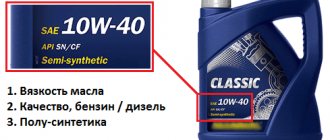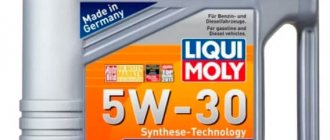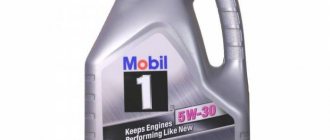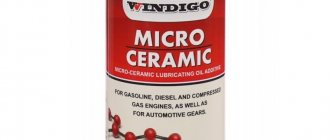Kia Rio 4 is a Korean B-class car, the best-selling Kia model on the Russian market. The car entered production in 2017, and its Russian version is produced in St. Petersburg. The car is available in hatchback and sedan bodies, and also has a new design compared to its predecessor, despite its similar design. Technically, the Rio is similar to the platform model of the Hyundai Solaris of both generations.
Since 2021, a restyled version of Rio has been produced, which has an updated design, an improved media system with a larger diagonal and an expanded set of options. The engine range includes gasoline engines of 1.4 (100 hp) and 1.6 liters (122 hp), operating with a six-speed manual or automatic transmission. Based on the 4th generation Rio, a cross-version of the Rio X-Line was created, which is distinguished by increased ground clearance (+10 mm), modified suspension and protective plastic body kits around the perimeter of the body.
When to change oil in 4th generation
You can decide when to change the oil based on the condition of the engine and signs indicating the need for replacement. Unpredictable regulations are especially relevant in cases where the operating mode of the vehicle differs significantly from the statistical average. For example, unscheduled replacement cannot be avoided in the following cases:
- frequent long-distance travel
- commercial use
- mileage exceeds 150 thousand km
- The engine is subject to constant stress due to towing trailers or off-road driving
When do you need to change the lubricant in the engine more often than recommended?
Conditions considered severe by the manufacturer are:
- frequent driving on dusty, uneven or congested roads;
- regular short trips (up to 16 km at low temperatures, up to 8 km at normal temperatures);
- long-term operation of the internal combustion engine at idle speed;
- frequent driving on sections of roads heavily treated with salt;
- use of a trailer, frequent towing of other cars;
- operation as a taxi, patrol car;
- driving in mountainous areas (with frequent descents and ascents).
If the Kia Rio is operated in such conditions, then the frequency of oil changes should be halved. Regular replacement will preserve the life of gasoline internal combustion engines installed on Korean cars.
Recommended replacement schedule
The frequency of oil changes often depends not only on operating conditions, but also on the design of the engine. This is due to the fact that automakers can introduce certain maintenance regulations for a certain type of internal combustion engine. However, even in this case, the replacement time falls within the range of 10-15 thousand kilometers. Of course, due to possible heavy loads, it will be necessary to deviate from this regulation and perform the replacement earlier than the stated deadline.
Features of oil consumption in various conditions
With a mileage of over 150 thousand km, engines already have a certain degree of wear, but under favorable conditions this does not cause accelerated clogging of the oil and a deterioration in its viscosity. However, in difficult conditions, the life of such an engine will inevitably come to an end, which is why excessive oil consumption is possible: its quality will deteriorate and the level will decrease. Based on this, in addition to factory regulations, it is equally important to take into account operating conditions:
| If in the city the oil service life can reach 600 hours, then on the highway this figure will be 250 hours |
| At speeds up to 130 km/h, nothing bad happens to the oil, since this is an absolutely acceptable speed limit for a modern car. However, if you constantly exceed this speed (constant trips on the highway at speeds above 130 km/h), then in this case the technical fluid has a high degree of wear. Here you can also add negative factors such as heat and frost, which worsen the condition of the lubricant. The same applies to extreme driving in city traffic jams, or active off-road use: driving on sand, snow, mud and frequent slipping. In such conditions, the vehicle’s components work to the limit, which inevitably leads to a reduction in maintenance schedules. |
| The oil change period is also affected by the condition of the fuel. A low-quality fuel mixture with a high sulfur content causes rapid oxidation of the oil and a sharp deterioration in its lubricating properties. |
Oil change period depending on oil type and engine
For gasoline engines
- Synthetics - 10-12 thousand km
- Semi-synthetics - 8-12 thousand km
- Mineralka – 3-5 thousand km
Functions of oil and why it is important to change oil on time
The need for timely oil changes is obvious, since a high-quality lubricant has three important functions on which the performance and durability of the engine depends.
| 1. Heat removal from heated components . Unlike a radiator with antifreeze, engine oil has a much more important task - namely, cooling in specific friction areas of parts |
| 2. Anti-corrosion protection . This function of the oil is extremely important under conditions of temperature changes and increased loads, which can cause mechanical damage, as well as oxidation and corrosion processes. Protection against them is provided by a durable oil film that envelops the internal combustion engine parts and thereby protects them from rust. |
| 3. The cleaning function of oil plays an important role in keeping the engine clean. Oil has the ability to collect and retain carbon deposits, metal particles, dust and soot. This prevents scratches and other damage on rubbing surfaces. |
Consequences of untimely oil changes
Based on the above, you can be sure that poor or low-quality oil does more harm than good for the engine. With high mileage, the beneficial properties of the oil deteriorate. In this case, large elements of wear products settle on the oil filter, while small fractions continue to circulate along with the oil along the highways, and thus contamination occurs. As a result, whistling, knocking and other extraneous sounds appear. Serious consequences of untimely replacement include cranking of connecting rod bearings, engine oil starvation, jamming of the camshaft, bent valves and sticking of piston rings. All this leads to a major overhaul of the engine.
How to determine oil aging
To check the condition of the oil, do the following:
- Warm up the engine
- Pull out the dipstick and drop a little oil on the paper
- Determine the condition of the oil by the color of the drop: - clear oil indicates a high concentration of water - light brown oil indicates a small amount of harmful deposits - dark brown color is a sign of a large accumulation of wear products - a black drop indicates that the oil has long been outdated and it needs to be changed urgently
Tips for changing oil in difficult conditions
- An early oil change is necessary in such extreme situations: - frequent off-road driving - staying in traffic jams - driving with semi-trailers and other heavy loads - sudden starts and braking
- For severe conditions, you should choose a high-quality branded oil that has sustainable beneficial properties
- With frequent vehicle downtime, condensation forms inside the engine, which leads to a change in the chemical composition of the lubricant. As a result, things can lead to corrosion of parts and serious problems with the internal combustion engine.
- Under heavy loads, it is important to prevent the engine from overheating in order to increase the oil change schedule and increase the service life of the internal combustion engine.
- Changing engine oil is carried out only on a warm engine
- High-quality oil must meet all factory requirements
Lubricant for Kia Rio 1st generation
Kia Rio 1 cars are equipped with 1.3 A3E and 1.5 A5E engines. The lubrication system of the first power unit must be filled with 3.3 liters of oil when replacing it. The 1.5 liter engine is a little larger – 3.4 liters.
The replacement interval is regulated; the oil needs to be updated every 10-15 thousand kilometers.
Answering the question of what kind of oil to pour into first-generation power units, it is worth noting that synthetics behave better throughout the year. Semi-synthetic oil with a viscosity of 10w-40 is used less often. The viscosity of synthetic motor oil is 5w30 or 5w40.
The list of motor oils most often used by car owners includes the following brands: Zic, Motul, Mobil, Castrol, Shell Helix.
What oil is better to pour into the engine?
For Kia Rio 4, two types of oil should be considered:
Semi-synthetic - designated as Semi-Synthetic and is a mineral oil with the addition of a small amount of synthetics, which slightly improves the basic properties of mineral oil. On the one hand, a liquid of this type can be equated to full-fledged synthetics, provided that we are talking about world-famous products. On the other hand, you need to understand that even the highest quality and most expensive semi-synthetics will not replace full-fledged synthetics
Synthetic is the best type of oil today. Therefore, owners of modern cars such as the Kia Rio 4 choose synthetics. This liquid is suitable for hot and frosty climates, since it is able to maintain its liquid consistency at any time of the year, while semi-synthetics are prone to freezing at extremely low temperatures. Moreover, synthetics best protect the engine from oxidative and corrosive effects, thoroughly clean all engine surfaces and prevent the formation of harmful deposits.
What groups of oils are there?
Summer oil - suitable only for operation in conditions with positive ambient temperatures. At low temperatures, the use of such oil can cause problems with starting the internal combustion engine, since summer fluid can thicken and freeze
Winter oil is the exact opposite of summer lubricant. On the contrary, such a liquid has a rare consistency and is not prone to freezing, which allows it to be used at extremely low temperatures. However, in hot conditions, winter oil becomes even thinner, which can be critical for cars with high mileage. For example, if microcracks are present, leaks may occur. In addition, even in summer conditions, such oil is not capable of forming a strong oil film to protect parts from dry friction and various damages.
All-season oil is most relevant for the Kia Rio 4 if the car is operated in Russian conditions with a variable climate. This liquid is not specialized, and therefore is suitable for any time of year. Therefore, all-season liquid is universal and easy to use.
Temperature
The best lubricants for Kia Rio 4 can be identified depending on the type of oil:
Semi-synthetic
Shell Helix HX7 5w-30
Liqui Moly Molygen New Generation 5W-20
Motul 6100 Save-lite 5W-20
Synthetic
Shell Helix Ultra Professional AM-L 5W-30 Total Quartz 9000 Future EcoB 5W-20 Castrol Magnatec Professional E 5W-20 Liqui Moly Synthoil High Tec 5W-30 Motul Specific 948B 5W-20
Choosing oil for Kia Rio: tips and tricks
The topic of choosing oil for Kia Rio is extensive. The entire model range of Korean cars is equipped with very reliable engines. However, if you do not carry out the required maintenance, without timely diagnostics, any, even the most reliable motor will begin to fail.
Regular oil changes in Kia Rio are one of the important stages in car maintenance. This is especially true for those cars that have already been in use for some time. The engine receives a serious load, and therefore suffers from premature wear without proper care.
The frequency of oil changes depends on the manufacturer's recommendations. To prevent wear and tear, the manufacturer recommends replacing the product at least every 10,000 km.
About three liters of liquid are poured into the engine. The obvious fact is that the oil needs to be changed promptly and regularly.
The main indicator for deciding whether an oil change is needed is its viscosity or degree of fluidity.
For Kia Rio engines, the manufacturer recommends oils with a viscosity of 5W-30 or 5W-20. Moreover, the latter option is more preferable for KIA, which are operated in Russia.
At the same time as the oil, service centers always change the oil filter. If you decide to carry out the replacement procedure yourself, take into account some of the features of Kia Rio engines of different years of manufacture.
For example, for cars of 2015, 2012, 2013, 2014, you can select several suitable options:
- Shell Helix Ultra;
- Total Quartz;
- Divinol;
- ZIC XQ LS.
Price-quality analysis shows that the best option among those presented is Shell Helix Ultra . The branded product includes the entire range of additives and minerals. Using it for the Korean Rio is quite justified. Shell does not lose its positive qualities with prolonged active use, which is also a definite plus for the oil of this company.
Total Quartz boasts impressive characteristics. This oil is also capable of keeping all engine parts in working condition. The price of a branded product is also not high. The original characteristics of the additives and minerals included in the oil retain their qualities even during long-term active use of the vehicle.
Divinol oil differs from previous ones in low consumption. Despite the fact that the brand has not received widespread advertising in the media, it is actively purchased by knowledgeable motorists. The option is quite suitable for KIA, as it copes with all engine protection functions.
ZIC oil is another product that is sold at an affordable price. The impressive list of additives included in its composition may alarm some. However, they directly affect the protection of the motor from premature wear. It can be safely poured into the Rio engine.
If we consider the choice of oil from the point of view of choosing a brand, then this exercise is practically useless. Each car owner has his own preferences. It is unlikely that anyone will want to change the brand just after reading one article.
Moreover, the Rio manufacturer does not recommend changing the brand of oil. If you purchased one specific product to replace it, then it is better to use it in the future. Or use the services of the same auto repair shop.
If you carefully study the technical specifications in KIA, you can highlight the following important information:
- Manufacturer's recommended engine oil is Shell HELIX;
- filling volume 3.3-3.49 liters;
- API Service classification – 4 or higher;
- temperature range for recommended viscosity values from -30С (5W20) to +50 (20W50)
At the same time, a reminder for the driver states that before pouring oil, you need to make sure that the surface near the filler cap, as well as the filler hole, is clean. The oil dipstick should also be clean.
These indicators are especially important if the car is operated in dusty, polluted conditions. For example, when driving on country dirt roads.
Timely cleaning of these parts (dipstick and cover) will protect the engine from dust and sand.
KIA Rio engines of later releases are made with no gaps between rubbing parts. Oil with a lower viscosity penetrates into gaps better, lubricating parts better.
Oil with a viscosity of 5W-40 almost does not flow into narrow gaps, leaving them without lubrication. Due to incorrectly filled oil, early engine wear occurs. That is why it is important to follow all manufacturer's recommendations when changing the oil.
This requirement applies to both gasoline and diesel engines.
It is more important to choose the right oil for the KIA engine not by brand name, but by API quality class, IlSAC. It is important to take into account that the manufacturer recommends a different oil for each generation of KIA.
The more modern the engine, the higher the quality the product should have. API SL and ILSAC GF-3, for example, are recommended only for first generation KIA.
Higher quality oils - API SM/SN and ILSAC GF-4/GF-5 - are quite suitable for cars produced in 2000-2005.
Rio 2005-2009 requires the use of API SM and ILSAC GF-4 oils. As in the previous case, the oil is of a higher quality, for example, API SN and ILSAC GF-5 are quite suitable options. Lower quality oil cannot be used.
In KIA Rio 2015 it is recommended to use API SN and ILSAC GF-5 quality oil. If we are talking about a KIA Rio with a diesel engine, according to the manufacturer’s recommendation, you should use oil of API CH-4 quality, but lower.
Recommended oil
It is important to use only high-quality and suitable oil to extend the life of the engine and ensure its smooth operation. Moreover, carefully selected lubricant reduces fuel consumption. Therefore, it is extremely important to pay attention to the factory specifications and tolerances before purchasing the appropriate oil.
So, in the case of Kia Rio 4, you need oil with the characteristics of API-SN and ILSAC GF-4, and ILSAC GF-5 is even better. Another important parameter is viscosity, which is selected depending on climatic conditions. For example, mainly in summer a viscosity of 20W-20 or 25W-50 is required. In winter, 0W-30, 0W-40 or 5W-30 is recommended, and for all-season use, 10W-40, 10W-30 or 5W-40 is suitable.
Based on the above parameters, the recommended engine oil for the Kia Rio 4 is the original Hyundai Turbo SYN Gasoline or Hyundai Premium LF Gasoline SAE 5W-20 synthetic fluid.
Kia Rio engine - how much oil
First generation DC, 2000-2005
Kia Rio DC in Russia and many developing countries had the status of an affordable entry-level family car, which was a worthy alternative to the post-Soviet models Samara and Lada 110. In addition, it was a relatively safe and comfortable car with a fairly spacious interior and high-quality assembly. The design of the car lacks proportionality, which is not a drawback due to the rather original and memorable streamlined shapes in the style of the 90s.
Also read: Motor oil for Lada Kalina engine
At least the car stood out from its closest competitors. The sedan and station wagon of the same name were offered with 1.3 and 1.5 liter petrol engines, as well as manual and automatic transmissions. In Russia, the car was produced only with a 1.5-liter engine.
Gasoline engines 2000-2005
- 1.3 75 l. With. A3D, oil volume - 3.3 liters, tolerance and viscosity: API-SH, SJ; SAE 5W-40, 5W-30, 10W-40, 10W-30, 0W-40, 0W-30
- 1.3 82 l. With. A3D, oil volume - 3.3 liters, tolerance and viscosity: API-SH, SJ; SAE 5W-40, 5W-30, 10W-40, 10W-30, 0W-40, 0W-30
- 1.5 97 l. With. A5D, oil volume - 3.4 liters, tolerance and viscosity: API-SH, SJ; SAE 5W-40, 5W-30, 10W-40, 10W-30, 0W-40, 0W-30
- 1.5 98 l. With. A5D, oil volume - 3.4 liters, tolerance and viscosity: API-SH, SJ; SAE 5W-40, 5W-30, 10W-40, 10W-30, 0W-40, 0W-30
Second generation JB, 2005-2011
Rio JB was a step forward compared to its predecessor - both in the field of design and technical equipment. The car received a new platform, more economical engines and additional equipment. Sound insulation and interior quality have been significantly improved. Thanks to this, Rio managed to distance itself from the budget image of the first model. In addition, the car became noticeably more expensive, but was still considered an affordable offer in comparison with the Volkswagen Polo and Ford Fiesta. The car was produced with 1.4 and 1.6 liter gasoline engines (95-112 hp) from its predecessor. A 1.5-liter diesel engine with 110 hp was also available. With. Transmissions: 5-speed manual and 4-speed automatic.
Gasoline engines 2005-2011
- 1.4 95 l. With. G4EE, oil volume - 3.3 liters, tolerance and viscosity: API-SH, SJ, SL, SM; SAE 5W-40, 5W-30, 10W-40, 10W-30, 0W-40, 0W-30
- 1.4 97 l. With. G4EE, oil volume - 3.3 liters, tolerance and viscosity: API-SH, SJ, SL, SM; SAE 5W-40, 5W-30, 10W-40, 10W-30, 0W-40, 0W-30
Third generation QB, 2011-2015
Despite the platform from Solaris, the Rio JB received a signature design concept in the style of the new Kia models of that time. The sporty and strict design of the front part distinguished the Rio from the more expensive Volkswagen Polo, which retained its “boring” design. Moreover, many changes have occurred in the interior of the new Rio.
Also read: Motor oil for Skoda Yeti engine
In particular, the dashboard has changed and a multimedia display has appeared on the center console. In addition, it has become much more convenient to control the climate settings, and the seating position and driver ergonomics have also improved. For the first time, the list of additional options includes heated windshield washer nozzles, a heated windshield and a light sensor. The engine range was borrowed from Solaris - petrol 1.4 and 1.6 liters (107 and 122 hp).
Gasoline engines 2011-2016
- 1.4 107 l. With. G4FA, oil volume - 3.3 liters, tolerance and viscosity: API-SM; SAE 5W-40, 5W-30, 10W-40, 10W-30, 0W-40, 0W-30
- 1.6 123 l. With. G4FC, oil volume - 3.3 liters, tolerance and viscosity: API-SM; SAE 5W-40, 5W-30, 10W-40, 10W-30, 0W-40, 0W-30
Fourth generation FB, since 2016
The Russian-made Kia Rio FB is an almost complete copy of a similar model called Kia K2. Among the stylistic changes, one can highlight the rear platform for the license plate, moved from the trunk lid to the bumper. In addition, the front of the car is distinguished by an original bumper and a new radiator grille, and a different multimedia system is installed in the cabin. Otherwise, the Rio FB is still a redesigned Solaris, but at the same time remains true to Kia’s corporate style. From the co-platform model, the car borrowed modernized aspirated engines with a volume of 1.4 and 1.6 liters (100-122 hp), operating with a manual transmission or automatic transmission.
Gasoline engines from 2017
- 1.4 100 l. With. G4LC, oil volume - 3.6 liters, tolerance and viscosity: API-SN; SAE 5W-40, 5W-30, 10W-40, 10W-30, 0W-40, 0W-30
- 1.6 123 l. With. G4FC, oil volume - 3.3 liters, tolerance and viscosity: API-SN; SAE 5W-40, 5W-30, 10W-40, 10W-30, 0W-40, 0W-30
What kind of oil was poured in from the factory?
At the factory, oil was poured into the engine of the Kia Rio 4 in accordance with the recommended parameters. One such lubricant is Shell Helix Ultra Professional AF 5W-20 . This oil is formulated with a synthetic base that meets stringent requirements. The characteristics of this product meet API-SM/SN and ACEA A1/B1 specifications.
Characteristics of Shell Helix Ultra Professional AF 5W-20
- Type – synthetic
- Purpose – for 4-stroke gasoline engines
- Viscosity – 5W-20
- API class – SN
- ACEA class – A1/B1
- Approvals – Ford WSS-M2C948-B
What do drivers prefer? List
- Eni i-Sint Tech Eco F 5W-20 is an oil with resistant to oxidation and corrosion. It features a wide range of useful properties that provide a long replacement interval. The fluid is made on a synthetic basis and is intended for gasoline engines. The i-Sint Tech VK 0W-20 line is available for use in any Kia engine. Both oil options (including 5W-20) save fuel
- Dragon Turbo Best is a semi-synthetic all-season oil at an affordable price. Its advantages are the optimal combination of alkaline and acid indicators for more reliable engine operation, as well as confident starting in cold weather. Thanks to this, oil with a viscosity of 5W-20 is almost as good as the 0W-20 version when it comes to cold starts. In addition, Dragon Turbo Best slightly reduces gasoline consumption due to the presence of molybdenum, and the beneficial effect of anti-wear additives is based on the use of boron
- Valvoline SynPower FE is a premium synthetic oil with stable additives that have protective and detergent properties. Their carefully selected composition is aimed at reducing CO2 emissions and improving engine performance throughout the entire speed range. Valvoline oil helps reduce fuel consumption and extend oil change intervals
- Neste City Pro F is one of the most economical motor oils today. It has a record low ash content, which makes it close to the 0W-20 version. The advantages of this oil are to ensure efficient starting of internal combustion engines at temperatures of minus 30 degrees or even lower. This is possible thanks to the presence of calcium-based detergent additives, as well as anti-wear additives based on zinc and phosphorus
- NGN Fusion 5W-20 is a universal synthetic for gasoline and diesel engines. It has a wide range of anti-wear additives and contributes to fuel efficiency. In addition, frequent oil changes are not required. It was originally developed for Japanese cars, although it is declared to be fully compatible with representatives of the Korean automobile industry
- Petro-Canada Supreme Synthetic is one of the best synthetic oils for the Kia Rio 4. Its feature is high-quality protection against counterfeiting, which is considered one of the signs of a high quality product. Supreme Synthetic oil has high cleaning properties and the ability to save fuel. In addition, the special properties of this liquid extend the life of a gasoline engine. For diesel engines, the recommended viscosity is 5W-30
- Lukoil Genesis Special FE is an oil from a well-known Russian company, which is a monopolist on the domestic market in the sale of lubricants. The advantages of this oil include easier engine starting in cold weather, as well as its efficient operation in urban environments with constant stops in traffic light jams. The main disadvantage of this line is its limited availability, because this oil is mainly available at official service stations
- GT-Oil is an oil from South Korean developers. It is a budget synthetic material suitable for the budget car Kia Rio 4. Compatibility with environmental standards Euro 4 and Euro 5 is declared, as well as resistance to evaporation and foam formation. In addition, the oil can save fuel and does not require topping up between shifts. Another important advantage of GT Oil is effective cold starting and reduced engine noise.
- Kixx is another Korean brand that offers its oils under the Mobis brand. This manufacturer also has a proprietary line of oils that can be poured into Kia cars directly at the factory. For Kia Rio 4, we recommend Kixx/Mobis oil, made on a synthetic base with a package of additives that reduce fuel consumption and reduce the volume of piston gases
- Eneos Premium Ultra is a highly purified oil that can make the Kia Rio 4 gasoline engine more economical. This oil is also characterized by oxidation resistance and low volatility.
- Idemitsu Zepro Euro is a high-quality Japanese product with a viscosity of 0W-20 or 5W-30 (instead of 5W-20). An oil with this SAE parameter is ideal for the Kia Rio 4. Its synthetic base and set of useful properties help save fuel and protect the internal combustion engine from premature wear
- Wolf OfficialTech 5W-20 MS-FE is an oil for speed enthusiasts. Such a liquid can improve the dynamic qualities of any engine, reduce acceleration time and even slightly increase the maximum speed. When driving slowly, the engine becomes almost silent
- Shell Helix Ultra Pro AF 5W-20 is one of the most popular oils for the Kia Rio 4. This synthetic product has a worldwide reputation, and its main features are protection against corrosion and deposits, as well as reduced engine noise and vibration.
- ZIC 0W-20 is a suitable oil option for Kia Rio 4 instead of 5W-20. Moreover, 0W-20 viscosity oil offers even better fuel economy and provides more efficient cold starts. As an alternative, a viscosity of 5W-30 is also suitable.
- Castrol Magnatec Professional E is an oil from a recognized leader in the lubricants market. A special feature of this line is the absence of dye, unlike many competitors with a greenish color. The key area of the beneficial properties of Castrol Magnatec Professional E oil is round-the-clock engine protection both during startup and warm-up, and under enormous loads
- Ravenol SFE SAE 5W-20 is a full-fledged synthetic with stable properties that do not disappear even with high mileage and last until the next oil change. This completely eliminates the possibility of an unscheduled oil change. Thanks to this, you can be sure of stable engine protection regardless of the load. Another feature is tungsten additives, which help minimize friction.
- Mobis is a type of Korean Kixx oil. It has effective detergent additives, which, in combination with a large amount of molybdenum, significantly reduce friction between parts, and also ensure quick start-up in frosty weather
- Motul 8100 Eco-Lite/Motul 6100 Eco-Lite is an oil from a renowned manufacturer, which is considered a monopolist in the field of advanced developments for new generation lubricants. When choosing such an oil for the Kia Rio, a viscosity of 5w-20 will be sufficient. The traditional advantages of Motul oils are gasoline savings, long intervals, optimal viscosity and protection against all types of deposits
- Mobil Super 3000 Formula F is an oil that can reduce fuel consumption and reduce the amount of harmful deposits over long vehicle mileage. Thus, the service life of the engine increases under any operating conditions - be it low or maximum engine speeds, driving on flat roads or rough terrain, smooth starts or sudden throttle changes in traffic jams, etc.
- Liqui Moly Special Tec 5W-20 is a German-made oil that is a specialized product for the Asian automotive industry.
Factory requirements for engine oil for Kia Rio
Motorists often change lubricants themselves. Monitor the cleanliness of the drain hole and dipstick and prevent dust and dirt from entering the oil container.
They also ensure that the engine oil for the Kia Rio 3 meets the following requirements:
- Fluidity. Running the rubbing elements of the unit “dry” leads to their premature wear. Due to its fluidity, the oil envelops them. However, the opposite property - viscosity - is important during long periods of inactivity: motor oil fills all cavities and does not flow down parts. This is especially important in frosty weather.
- Ability to contact metal surfaces. When the engine is running, the oil heats up. It liquefies and loses its lubricating properties. Therefore, an important indicator of lubrication is the ability to form a thin film on rubbing parts. To obtain such characteristics, manufacturers use additives. In hot weather they add thickness to the liquid, in cold weather they make it more fluid.
- Engine cleaning. During operation of the unit, combustion products are formed on its parts, which then enter the lubricant and settle in the filter. Thanks to this, engine elements remain clean and operate longer.
- Corrosion protection. There is always some amount of water vapor in the motor. The lubricant prevents metal corrosion from developing.
Engine fluid cools the rubbing elements of the engine and fills the gaps between them.
What are the tolerances depending on the type of oil, engine and year of manufacture of the car?
Year of release – 2016
- All-season – 10W-40, 10W-50, 15W-40, 5W-40
- Winter – 0W-40, 5W-40, 5W-50
- Summer – 20W-40, 25W-40, 25W-50
- Type – synthetics, semi-synthetics SM
Year of release – 2017
- All-season – 10W-50, 15W-40, 5W-40
- Winter – 0W-40, 5W-50
- Summer – 20W-40, 25W-50
- Type – synthetic SN
Year of release – 2018
- All-season – 10W-50, 15W-40, 15W-50
- Winter – 0W-40, 0W-50
- Summer – 20W-40, 25W-50
- Type – synthetic SN
Year of release – 2019
- All-season – 10W-50, 15W-40, 15W-50
- Winter – 0W-40, 0W-50
- Summer – 20W-40, 25W-50
- Type – synthetic SN
Year of release – 2020
- All-season – 5W-50, 10W-50
- Winter – 0W-50
- Summer – 15W-50, 20W-50
- Type – synthetic SN
Year of release – 2021
- All-season – 5W-50, 10W-60
- Winter – 0W-50, 0W-60
- Summer – 15W-50, 15W-60
- Type – synthetic SN
Year of release – 2022
- All-season – 5W-50, 10W-60
- Winter – 0W-50, 0W-60
- Summer – 15W-50, 15W-60
- Type – synthetic SN
Oil consumption
The condition of the power unit can be assessed based on many criteria, including oil consumption. Exceeding the permissible flow rate is the cause of a malfunction or poor quality of the lubricant. Of course, a sharp increase in oil consumption will alert any car owner who has to find out the reason for the excess consumption. It is important to keep in mind that failure to promptly monitor the condition of the oil (for example, its poor quality or low level) can lead to costly repairs.
What determines oil consumption?
- on the characteristics and degree of wear of the engine (power, number of cylinders, age)
- on climatic conditions and frequency of maintenance
- on the condition of the filter (if it is clogged or damaged, then oil consumption will naturally increase)
- on the characteristics of the oil itself
Normal oil consumption
During the break-in period during the first 5000 km, oil consumption should not exceed 1 l/1000 km. This consumption is considered acceptable even after replacing the piston rings. Below are the oil consumption rates in constant operation mode for runs of 5-150 thousand km (after running-in)
- 0.25 l/1000 km – in favorable conditions
- 0.4 l/1000 km – at high speeds and with increased loads
- 0.5 l/1000 km – in mountain conditions
What is the consumption rate for a car with high mileage?
If the car's mileage exceeds 150 thousand km, then the consumption rate is considered to be 0.35-0.55 liters.
What is the oil consumption per 100 liters of fuel?
| For new gasoline engines | 25 ml |
| For older gasoline engines | 100 ml |
There are cases when oil consumption is 0.5 l/100 l of fuel. This indicator is still considered acceptable, but undesirable. In this case, there is a high risk of the engine jamming while driving, so it is better to immediately contact a service station to solve the problem with overrun.
Oil change intervals
The manufacturer states that the oil needs to be changed every 10 thousand km. But service specialists urge you to do this when the product has reached 80-90% of its standard life, i.e. after 8-9 thousand km.
This advice is optimal for those who drive a lot on the highway or on open roads in the city.
If we are talking about constant stops in traffic jams, you will need to fill a new portion after 7 thousand km.
Causes of premature wear
There are 3 key reasons for increased wear of the protective lubricant mixture:
- Driving on low quality gasoline. When such fuel burns, more soot is released. The consequence of this is contamination of the lubrication supply system.
- Poor engine condition. As cylinder compression decreases, the proportion of combustion products in the engine housing increases.
- Aggressive driving. First of all, operation in “start-stop” mode.
How often and what kind of oil should be poured into the Priora. We talk about the best motor oils for Lada Priora and tips that will help extend the life of the car and save money.
Fat burning: causes and solutions
- Plug leakage occurs when the engine is warm and under load. To check this version, you need to warm up the engine and see if there is an oil puddle under the car
- Poor quality oil not only leads to excess consumption, but can also be the cause of many other problems. In this regard, it is recommended to purchase oils with protection against counterfeiting. Such products include Ravenol, Mobil, Shell, etc.
- Oil separator malfunction. To check this version, you need to assess the degree of contamination of the oil separator outlet pipe. If it is in good working order, then it will have a small amount of plaque in the form of ash at its output.
- Coking of the piston rings of the cylinders occurs due to the aging of the oil, which only dirty the engine and does not bring any benefit. Such fluid primarily affects the cylinder oil scraper rings, which over time become clogged with dirt and malfunction. As a result, oil enters the combustion chamber of the fuel in large quantities. Prevention will help solve the problem: thorough washing and changing the oil three times. In the worst case, you will have to contact a service center for washing with a special agent (the procedure is called ring decarbonization)
- Piston rings are damaged. In this case, the problem of excessive oil consumption will be relevant even after washing the piston rings, which are seriously worn out and must only be replaced
- Poor fuel quality, wear of spark plugs or ignition coils, problems in the fuel system - all this causes rapid aging and excessive oil consumption.








